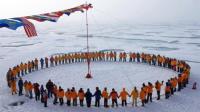 Reports are that Canada is filing a claim to extend its northern sea boundary to encompass an area of over 1 million square miles of Arctic seafloor which includes the North Pole, under provisions of the United Nations Convention on the Law of the Sea (UNCLOS). The Canadian are said to have spent the past 10 years and $200 million dollars to document the claim that they are expected to file with the UN today. A preliminary assessment by the US Geological Survey suggests the Arctic seabed may hold as much as 25 percent of the world’s undiscovered oil and natural gas reserves. PressTV reports that “Experts say a decision on the Arctic seafloor is probably 20 years away, with scientific evaluation on Canada’s claim taking roughly five years.”
Reports are that Canada is filing a claim to extend its northern sea boundary to encompass an area of over 1 million square miles of Arctic seafloor which includes the North Pole, under provisions of the United Nations Convention on the Law of the Sea (UNCLOS). The Canadian are said to have spent the past 10 years and $200 million dollars to document the claim that they are expected to file with the UN today. A preliminary assessment by the US Geological Survey suggests the Arctic seabed may hold as much as 25 percent of the world’s undiscovered oil and natural gas reserves. PressTV reports that “Experts say a decision on the Arctic seafloor is probably 20 years away, with scientific evaluation on Canada’s claim taking roughly five years.”
The Canadians are not alone in their claims. Russia, Denmark, Norway, and the United States all claim overlapping sections of the Arctic seas and sea floor. Of the group, the United States is alone in not having ratified the UNCLOS treaty.
Currently both Russia and Canada are claiming the North Pole. The United Nations Convention on the Law of the Sea has provisions and clauses for adjudicating conflicting claims. Disturbingly, however, it does not appear to have a Santa clause. (Sorry.) Thanks to Phil Leon for contributing to this post.

With conflicting claims for the “ownership” of the North Pole it would seem impractical to designate it to one Nation. Perhaps a solution would be from 90°North out to 83°North declared as an International Maritime Zone with no exploitation except for ice studies with prior clearance from the United Nations. This would still “Rights of Innocent Passage” to icebreakers and ice-classed vessels capable of transit. Clearly other areas could be considered for inclusion in National Territories of bordering Nations.
Good Watch.
At the request of my very concerned grandchildren inquires were made to S.Claus Rednose Industries Inc. Christmas Outfitters. NAUTICAL LOG was just informed that all is well with Father Christmas and the usual reindeer-powered sleigh voyage would once again go ahead as planned.
Good Watch.
But which North Pole, the Geographic North Pole or Terrestrial North Pole, and how, the darn thing keeps moving all over the place.
All three names refer to the same 0°North Latitude being the point at which the Earth’s axis of rotation meets the surface. This point does very slightly drift in a controlled circular motion called nutation. Perhaps you were thinking of the magnetic pole which is considerably farther away. On our Canadian icebreaker on Artic Patrol the magnetic compass was useless at high latitudes so we had two independent gyro systems for directional purposes one Sperry the other Arma-Brown. We also used navigational charts based on Polar Projection while in that region.
Good Watch.
Further to my last comment the Magnetic North Pole is currently at about 86°North Latitude and 147°West Longitude and is outside Canadian Arctic territorial claim.
Good Watch.
Pingback: Gigaclaim op Noordpool | Bootjesgek.nl